In the pursuit of reliable and valid scientific knowledge, two fundamental concepts stand out: repetition and replication. While often used interchangeably in casual conversation, they represent distinct approaches to validating experimental findings and ensuring the robustness of research.
Understanding the nuances between these two concepts is crucial for evaluating the credibility of scientific claims and fostering a culture of rigorous inquiry.
Table of contents
Key Difference Between Repetition and Replication
| Feature | Repetition | Replication |
| Purpose | To establish the consistency and reliability of results within a single study. | To assess the generalizability and robustness of findings across different studies. |
| Focus | Internal validity: ensuring that the observed effects are truly due to the independent variable. | External validity: determining whether the findings can be applied to other populations, settings, and conditions. |
| Researcher(s) | Typically performed by the same researcher(s) who conducted the original experiment. | Conducted by independent researcher(s) who were not involved in the original study. |
| Study Context | Occurs within the same study. | Involves conducting a new, independent study. |
| Methodological Variations | Aims to maintain identical methods and materials as the original experiment. Minimal to no variations. | May involve variations in methods, materials, or settings to test the robustness of the findings. |
| Goal | Minimize the impact of random error and enhance the precision of measurements. | Minimize the impact of researcher bias and assess the consistency of findings across different contexts. |
| Data Analysis | Focuses on statistical analysis of multiple trials within the same dataset. | Involves comparing the results of independent studies, often using meta-analysis techniques. |
| Scope | Narrow: focuses on confirming findings within a specific experimental context. | Broad: aims to generalize findings to a wider population or range of conditions. |
| Addressing Errors | Helps identify random errors and inconsistencies in the experimental procedure. | Helps identify systematic errors or limitations in the original study design. |
| Types | Internal replication, direct repetition, within experiment replication. | Strengthens statistical power of an overall hypothesis across many trials. |
| Statistical outcome | strengthens statistical significance within that experiment. | Strengthens the statistical power of an overall hypothesis across many trials. |
| Resource use | Generally less resource intensive. | Generally more resource intensive. |
| publication outcome | usually not published independently. Part of the study results. | Direct replication, conceptual replication, and external replication. |
| Time frame. | Conducted in a concise time period. | can be conducted over a long period of time, by many different research teams. |
What is Repetition?
Repetition, also known as internal replication or direct replication within a single experiment, focuses on the consistency of results obtained by the same researcher(s) using the same methods and materials within the same study. It aims to demonstrate the reliability of the experimental procedure and reduce the impact of random error or chance variation.
Here’s a breakdown of the key aspects of repetition:
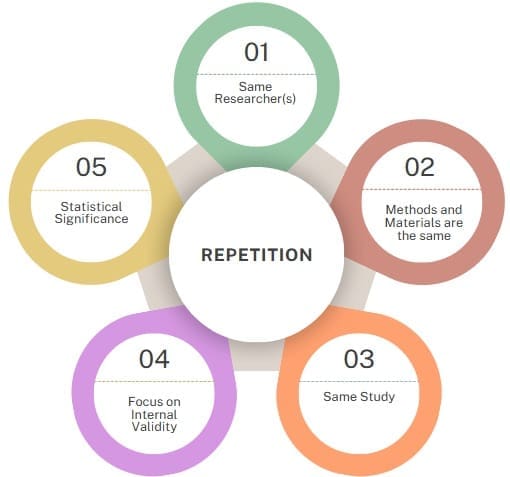
- Same Researcher(s): Repetition is typically conducted by the same researcher or research team who performed the original experiment. This ensures consistency in the application of the protocol and minimizes variations introduced by different individuals.
- Methods and Materials are the same: The core principle of repetition is to maintain identical experimental conditions. This includes using the same equipment, reagents, participants (if applicable), and procedures as the original experiment.
- Same Study: Repetition occurs within the context of a single study. It involves conducting multiple trials or measurements under the same experimental conditions to assess the consistency of the observed results.
- Focus on Internal Validity: Repetition primarily addresses internal validity, which refers to the extent to which a study establishes a causal relationship between the independent and dependent variables. It helps to ensure that the observed effects are not due to random fluctuations or errors in the experimental procedure.
- Statistical Significance: Repetition often involves statistical analysis to determine whether the observed variations in results are statistically significant. If the results are consistent across multiple trials, the statistical significance of the findings is strengthened.
Examples
- A chemist performs multiple titrations to ensure the accuracy of a concentration measurement.
- A psychologist administered a survey multiple times to the same group of participants to assess the reliability of their responses.
- A biologist measures the growth rate of a plant multiple times under controlled environmental conditions.
Benefits of Repetition
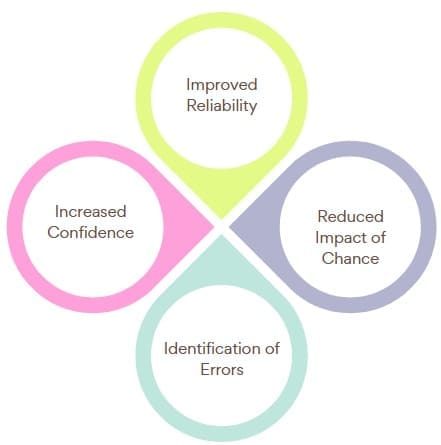
- Improved Reliability: Repetition enhances the reliability of experimental results by demonstrating their consistency and reducing the impact of random error.
- Reduced Impact of Chance: Conducting multiple trials minimizes the likelihood that observed effects are due to chance variations.
- Identification of Errors: Repetition can help to identify errors in the experimental procedure or data collection, allowing researchers to refine their methods and improve the accuracy of their findings.
- Increased Confidence: Consistent results across multiple trials increase the researcher’s confidence in the validity of their findings.
Limitations of Repetition
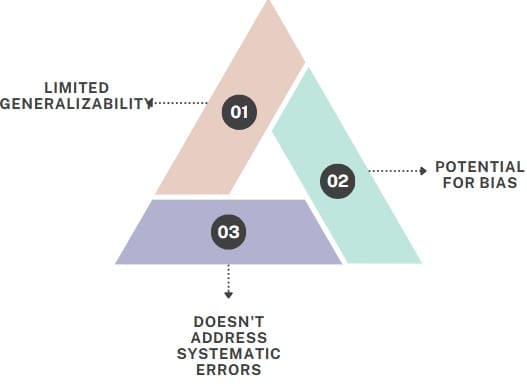
- Limited Generalizability: Repetition primarily addresses internal validity and does not necessarily ensure that the findings are generalizable to other populations, settings, or conditions.
- Potential for Bias: If the researcher conducting the repetition has a vested interest in the outcome of the study, there is a potential for bias to influence the results.
- Doesn’t Address Systematic Errors: Repetition will not uncover systematic errors in the original experimental design. If the original design is flawed, the errors will be repeated.
What is Replication?
Replication, also known as external replication or independent replication, involves conducting a study that attempts to reproduce the findings of a previous study using different researchers, methods, materials, or settings. It aims to assess the generalizability and external validity of the original findings.
Here’s a breakdown of the key aspects of replication:
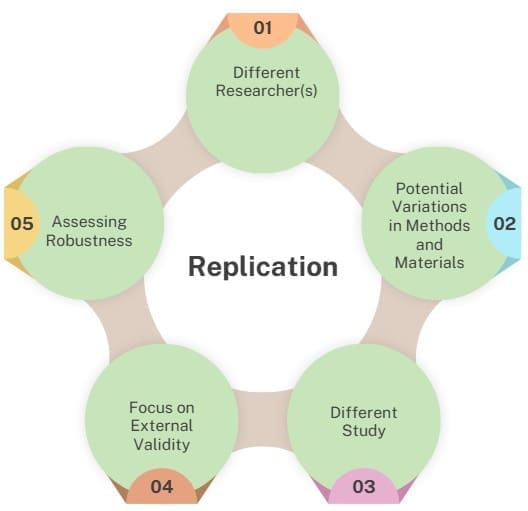
- Different Researcher(s): Replication is typically conducted by independent researchers who were not involved in the original study. This helps to minimize bias and ensures that the findings are not specific to a particular research team.
- Potential Variations in Methods and Materials: While replication aims to reproduce the core elements of the original study, it may involve variations in methods, materials, or participants. This allows researchers to assess the robustness of the findings across different conditions.
- Different Study: Replication involves conducting a new, independent study that is designed to test the same research question as the original study.
- Focus on External Validity: Replication primarily addresses external validity, which refers to the extent to which the findings of a study can be generalized to other populations, settings, and conditions.
- Assessing Robustness: Successful replication of a study’s findings provides strong evidence that the results are robust and not limited to the specific circumstances of the original experiment.
Also See: Lean Six Sigma Certification Programs, Garland, Texas
Types of Replication
- Direct Replication: this type of replication attempts to repeat the original experiment as closely as possible.
- Conceptual Replication: this type of replication tests the same research question as the original study but uses different methods or measures.
Examples
- A group of psychologists in one country replicated a study on cognitive biases that was originally conducted in another country.
- A team of biologists replicating a study on the effects of a new drug on cancer cells using different cell lines or animal models.
- Different programming groups recreated the functions of a computer algorithm that was produced by another group.
Benefits of Replication
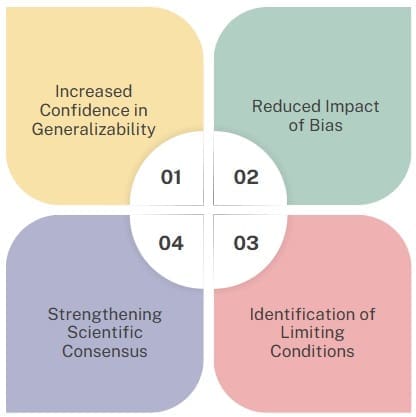
- Increased Confidence in Generalizability: Successful replication of a study’s findings provides strong evidence that the results are generalizable to other populations, settings, and conditions.
- Reduced Impact of Bias: Replication by independent researchers minimizes the potential for bias to influence the results.
- Identification of Limiting Conditions: Replication can help to identify the limiting conditions under which a phenomenon is observed.
- Strengthening Scientific Consensus: Consistent results across multiple replications contribute to a stronger scientific consensus on a particular topic.
Limitations of Replication
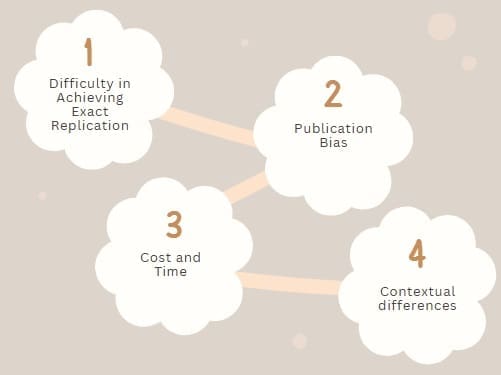
- Difficulty in Achieving Exact Replication: It is often difficult to achieve exact replication of a study due to variations in methods, materials, and settings.
- Publication Bias: There is a tendency for journals to publish positive results, which can make it difficult to publish replication studies that fail to confirm the original findings.
- Cost and Time: Replication studies can be costly and time-consuming, which can limit the number of replications that are conducted.
- Contextual differences: even when attempting direct replication, there are often subtle contextual differences between two different trials. These contextual differences can affect the outcome of the replication.
Key Differences Between Repetition and Replication
Understanding the distinctions between repetition and replication is crucial for designing rigorous experiments and interpreting scientific results accurately.
Scope
Repetition: Occurs within a single experiment, focusing on internal consistency.
Replication: Involves independent experiments, emphasizing external validity.
Timing
Repetition: Conducted contemporaneously, during the same experimental session.
Replication: Performed at different times, potentially by different researchers.
Control Over Variables
Repetition: Maintains constant conditions to assess measurement reliability.
Replication: Allows for variations to test the robustness of findings across diverse settings.
Purpose and Objective
Repetition: Aims to reduce random error and increase precision within a study.
Replication: Seeks to verify results and establish generalizability across studies.
Outcome Evaluation
Repetition: Evaluate the consistency of results within the same experimental framework.
Replication: Assesses the consistency of findings across different experimental contexts.
Importance of Both Repetition and Replication
Both repetition and replication are essential for ensuring the rigor and reliability of scientific research. Repetition helps to establish the internal validity of a study, while replication helps to assess its external validity.
Ideally, scientific studies should involve both repetition and replication. Researchers should strive to conduct multiple trials within their own studies to ensure the consistency of their findings, and independent researchers should be encouraged to replicate important studies to assess their generalizability.
By embracing the principles of repetition and replication, we can strengthen the foundation of scientific knowledge and increase our confidence in the reliability and validity of scientific findings.
The scientific community should encourage and incentivize replication, and publishing failed replications is just as important as publishing successful ones. Increasing the transparency of experimental methods is also a must for increasing the feasibility of replication.
Final Words
Repetition and replication are both essential components of scientific research, but they serve distinct roles. Repetition focuses on the reliability and precision of data within a single experiment by performing multiple trials. It ensures that observed results are not due to random error and enhances confidence in the conclusions drawn from the data.
On the other hand, replication involves conducting an entirely new experiment, often by different researchers or in different settings, to verify the generalizability of the results. It helps establish whether the findings can be consistently reproduced across different conditions and contexts, thus confirming their broader applicability.
By understanding and utilizing both repetition and replication appropriately, researchers can strengthen the validity of their findings, increase the credibility of their studies, and contribute to the overall progress of scientific knowledge.

About Six Sigma Development Solutions, Inc.
Six Sigma Development Solutions, Inc. offers onsite, public, and virtual Lean Six Sigma certification training. We are an Accredited Training Organization by the IASSC (International Association of Six Sigma Certification). We offer Lean Six Sigma Green Belt, Black Belt, and Yellow Belt, as well as LEAN certifications.
Book a Call and Let us know how we can help meet your training needs.



















